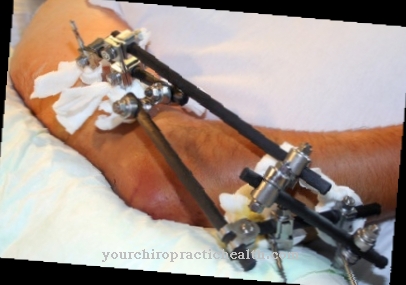At a enema fluid is passed through the anus into the intestine. Mostly it is water. This can also be mixed with various additives such as table salt or glycerine. The indications for an enema can be diagnostic or therapeutic in nature.
What is the enema?

Different devices with different capacities can be used for one inlet. Well-known devices for performing an enema are irrigators, enema pumps or pear syringes. The liquid content is between 50 and 800ml. The most common form of application is the enema.
The flush volume here is a maximum of 200ml. There are special enema pumps for self-use. With these, liquid can be sucked in and injected into the anus using an integrated ball pump. Irrigators are used for passive enemas. To do this, a tube that is connected to a fluid container is inserted into the anus. The liquid container is hung up so that the water can flow through the anus into the intestine.
There are numerous medical indications for an enema. Enemas and enemas are also used to prepare for anal intercourse or can be part of sexual practices in the field of clinical eroticism or BDSM.
Function, effect & goals
Most often, the enema is used as a laxative measure. This happens, for example, in the case of stubborn constipation, intestinal obstruction, for colon cleansing before fasting cures, before operations or before giving birth. The laxative enema is usually carried out by means of an enema, which results in a quick stool.
The effect of the enema can be enhanced by various techniques. Lowering the temperature of the enema fluid to about 32 ° C has a stimulating effect on the intestine, as does inserting a longer intestinal tube. In children or infants, simply inserting a clinical thermometer into the anus has a laxative effect. Various agents can also be added to the rinsing liquid, which in most cases is water, which also lead to an improved effect. For example, olive oil or milk soften the stool, table salt or sorbitol increase the osmotic effect.
In certain cases it is necessary to administer drugs that are usually administered orally to the body via an enema. This can be the case if the patient is acutely unable to take the drug orally. Anal application is also suitable for children. The administration of medication via enema also has various advantages. On the one hand, the first pass effect is reduced. Every orally administered agent first passes through the liver before it ends up in the blood and later ends up in the target organ. The first pass effect describes the conversion of the medicinal substance in the liver. If the drug is administered anally, part of the active ingredient passes through the intestinal mucous membrane of the rectum directly into the bloodstream and thus reaches the target organ more quickly and in its original form.
Also, drugs that taste bad or that are acid-sensitive and that would destroy stomach acid can be administered using an enema. In the case of so-called hepatic encephalopathy, that is, brain damage caused by liver cirrhosis, a lactulose enema is often performed. The cause of the damage to the brain is ammonia in the blood, which the damaged liver can no longer break down. The lactulose contained in the rinsing liquid is supposed to bind this ammonia so that it can then be excreted more easily.
A Resonium enema, on the other hand, is performed in acute or chronic renal insufficiency. The damaged kidneys can no longer excrete sufficient potassium. Resonium is a drug that is used to exchange potassium ions for sodium ions. It is used by means of a single enema. It must remain in the patient's anus for between four and ten hours for optimal effect. If this is not possible, the application must be repeated.
Enemas can also be used to reduce fever. This used to be a common procedure, but it has apparently gone out of fashion. For the antipyretic enema, lukewarm water is mixed with a pinch of salt and rinsed into the intestine. The amount of liquid should be up to 100ml for infants, up to 250ml for small children and between 500 and 600ml for older children and adults. This technique can lower the fever by about one degree.
An enema can be used not only for therapeutic but also for diagnostic purposes. To do this, a contrast agent is added to the rinsing liquid. This then reaches the patient's large intestine via the anus and is distributed there. This is followed by another rinse to empty the bowel and remove excess contrast medium. The intestine is stretched through air insufflation, i.e. the blowing in of air.
In the following x-ray examination, the colon can now be shown on the x-ray. Enemas are also given to diagnose faecal incontinence. The amount of fluid that can be filled in until it exits through the anus muscle is measured. In a further experiment, 500 ml of liquid are filled into the rectum and the time is measured that the patient can consciously hold the substance before defecation occurs.
Risks, side effects & dangers
If there is an intestinal obstruction or acute abdominal disease, an enema should not be performed or should only be performed under the detailed instruction of a doctor. Caution should also be exercised in the case of congenital malformations of the anus, hemorrhoids, pregnancy and chronic inflammatory bowel diseases such as Crohn's disease or ulcerative colitis.
Too high or too low a temperature of the rinsing liquid can cause scalds or cramps in the bowel. If the irrigation devices are used improperly, there is a risk of injury to the intestinal wall or the anus.
It is essential to ensure that the flushing liquid is harmless. Too high an alcohol or acid content irritates the intestinal mucosa. Chamomile tea, which was previously often used for enemas in inflammatory bowel diseases, is not recommended as a rinsing liquid. Asthmatics or allergy sufferers are at risk of anaphylactic shock. In the worst case, this can be fatal. Enemas that are performed too often can also damage the intestinal flora.
Typical & common bowel diseases
- Crohn's disease (chronic bowel inflammation)
- Inflammation of the intestine (enteritis)
- Intestinal polyps
- Intestinal colic
- Diverticulum in the intestine (diverticulosis)
























.jpg)



